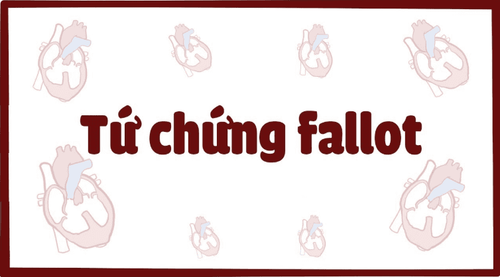This is an automatically translated article.
Fallot's tetralogy is the most common congenital heart disease with cyanosis, accounting for 75% of cases of cyanotic TBS in children over 1 year old, including 4 heart defects (tetrads) namely: ventricular septal defect, pulmonary stenosis, arteriosclerosis The aorta rides on the interventricular septum, right ventricular thickening. These heart defects reduce blood flow to the lungs and bring hypoxic blood to the body, so children have a long-term lack of oxygen, easily fatigue and have cyanosis. Some children with mild disease may not see symptoms of cyanosis.
1. Causes of Tetralogy of Fallot
Tetralogy of Fallot occurs during pregnancy, when the baby's heart is forming. Factors such as poor maternal nutrition, viral infections or genetic disorders may increase the risk of this disease, but in most cases the cause remains unknown.
1.1. Who usually gets tetralogy of Fallot? Tetralogy of Fallot is usually diagnosed while the baby is two months old. Parents can limit their child's chances of getting the disease by minimizing risk factors.
1.2. What factors increase the risk of tetralogy of Fallot? There are many factors that can increase the risk of tetralogy of Fallot, including:
A viral infection in the mother, such as Rubella (German measles) or alcoholism during pregnancy;

Nhiễm rubella trong giai đoạn thai kỳ, trẻ sinh ra có nguy cơ cao mắc tứ chứng fallot
Improper nutrition; Pregnant mothers over 40 years old; Parents with tetralogy of Fallot; Babies born with Down syndrome or DiGeorge syndrome.
2. Manifestations and complications of the disease
Purple skin, mucous membranes. The time of appearance is not certain, it may be immediately after birth or later (after 4-6 months). Cyanosis increases with exertion (cry, suckling, etc.). Syncope due to lack of brain oxygen. Thirst due to increased blood concentration. Cupped fingernails, clubbed fingers and toes, appear after 2-3 years. Red spots appear on the eye conjunctiva. Slow physical and mental development. In addition, children with tetralogy of Fallot may also experience complications such as:
Cerebrovascular thrombosis, brain abscess, prolonged anemia, physical growth retardation, easy bleeding gums, skin, digestion Infective endocarditis coincident...

Tứ chứng Fallot ở trẻ gây biến chứng viêm tắc mạch máu não
Medical treatment is only temporary while waiting to choose the right time for surgery. During hospital stay, children are given iron and protein supplements; fluids to reduce hemoconcentration; take propranolol to reduce symptoms; prevention and treatment of cyanosis.
Surgical treatment includes: Temporary surgery and radical surgery. Radical surgery can be primary (without temporary surgery) or radical surgery in two stages (with a temporary surgical phase). The time and method of surgery will be decided by the surgeon by assessing the health, weight of the child, the severity of the disease, the severity of the symptoms.
3. Caring for a child with tetralogy of Fallot
If the child is found to have cyanosis or signs of a congenital heart defect such as: respiratory inflammation, poor appetite, growth retardation, etc., the child should be taken to a cardiology hospital for examination and confirmation. Diagnosis of TBS and appropriate treatment.
Parents of children with tetralogy of Fallot should note:
Take the child to the hospital immediately if the child has difficulty breathing, fatigue, weakness, irritability, increased cyanosis... If the child has a bout of cyanosis, immediately comfort, Reassure the child, loosen the clothes, and place the child in the “chest pillow position”: lying on his side with his knees drawn to his chest. This position helps increase blood flow to the lungs, the child will be less purple and less tired. Then, immediately take the child to the hospital for timely treatment. Children need to drink a lot of water, eat nutritious food, eat foods rich in iron (red meat like pigs and cows; vegetables, cereals; sesame seeds, sunflower seeds, beans... ).

Vệ sinh răng miệng cho trẻ thật tốt để tránh bị nhiễm trùng
For young children, it is necessary to feed them slowly and divide them into many small meals during the day, to keep them clean and warm, to avoid letting them cry, to avoid letting them have a fever or diarrhea... For children As children grow older, they need antibiotics during a procedure or dental treatment to prevent infective endocarditis, and need to maintain good oral hygiene to avoid infection. Avoid allowing children to exercise vigorously or play too much. Avoid letting your child exert himself and do heavy work. Follow-up check-ups according to the cardiologist's appointment for timely monitoring and treatment.
4. Effective treatment
The first test is an echocardiogram. In addition, the doctor will also order blood tests, electrocardiograms, chest X-rays to get accurate diagnosis results.
For most children with deformities, surgery is the only optimal treatment.
Surgery involves closing the ventricular septal defect with a patch and clearing the blocked blood vessel from the right ventricle to the lung. There are two types of surgery that can be done, including heart surgery and a temporary procedure that uses a bridge (shunt). Most children will have heart surgery.
Heart surgery This type of surgery is usually done during a child's first year. During this procedure, the surgeon places a covering over the septal defect to close the hole between the two ventricles. The doctor will also repair the stenosis of the pulmonary valve and widen the pulmonary artery to increase blood flow to the lungs. After surgery, the oxygen level in the blood increases and the baby's symptoms subside.

Dựa trên tình trạng bệnh và sức khỏe của bé bác sĩ sẽ lên phương án điều trị phù hợp
Temporary surgery Sometimes children need temporary surgery before being repaired in the heart. If your baby is born prematurely or has pulmonary hypoplasia, the doctor will create a bridge (shunt) between the aorta and the pulmonary artery. This flow will increase pulmonary blood flow. When the child is ready for heart surgery, the shunt is removed.
5. What habits help limit the progression of tetralogy of Fallot?
Maintain good personal hygiene, use prophylactic antibiotics to avoid infective endocarditis. Relative iron deficiency should be detected and treated. Iron-deficient children are more likely to have cerebrovascular complications. Give fluids to avoid thrombosis and thromboembolism. Prevent infection: A child with a severe heart defect may need prophylactic antibiotics before surgery. Your doctor can help you decide when it's necessary. Regular dental visits help prevent infections. Exercise needs to be considered on a case-by-case basis, ask your doctor about activities that are safe for your child.

Trung tâm tim mạch Vinmec Central Park rất thành công với nhiều ca bệnh
Vinmec Central Park International General Hospital has routinely performed patients from small children to adults with congenital heart disease tetralogy of Fallot and achieved very positive results with a success rate of surgery up to up to 95%, the rate of pulmonary valve preservation is high. (If pulmonary valve preservation is not achieved during complete surgical repair of tetralogy of Fallot, most patients require multiple hospitalizations in their lifetime for biological pulmonary valve replacement every 8-10 years.)
The surgery was performed by Dr. BS.Nguyen Luong Tan - Head of Cardiology Department - Vinmec Central Park International General Hospital. The doctor is an expert in the field of thoracic and cardiovascular surgery in adults and children. The doctor is well-trained in the country and many centers have the world's leading medical background such as France, Australia,...
Along with that is the support from a system of modern equipment and machines that are used by the patient. Investment hospital for surgeries: Maquet's HR20 Artificial Cardiopulmonary System, Avance CS2 Anesthesia Machine, GE's R860 Ventilator, the world's most modern IGS730 Hybrid Operating Room.
The advantages of tetralogy of Fallot congenital heart surgery are:
After the repair in the heart, the oxygen level in the blood increases and the child's symptoms are reduced. Helps restore cardiovascular functions, prolonging patient's life
Please dial HOTLINE for more information or register for an appointment HERE. Download MyVinmec app to make appointments faster and to manage your bookings easily.













